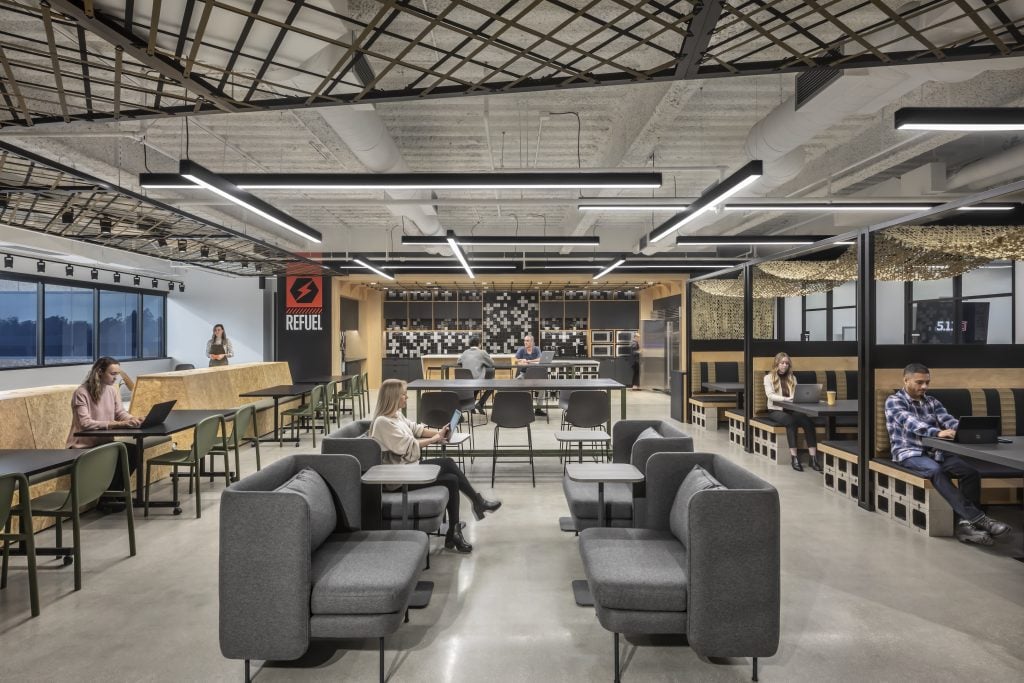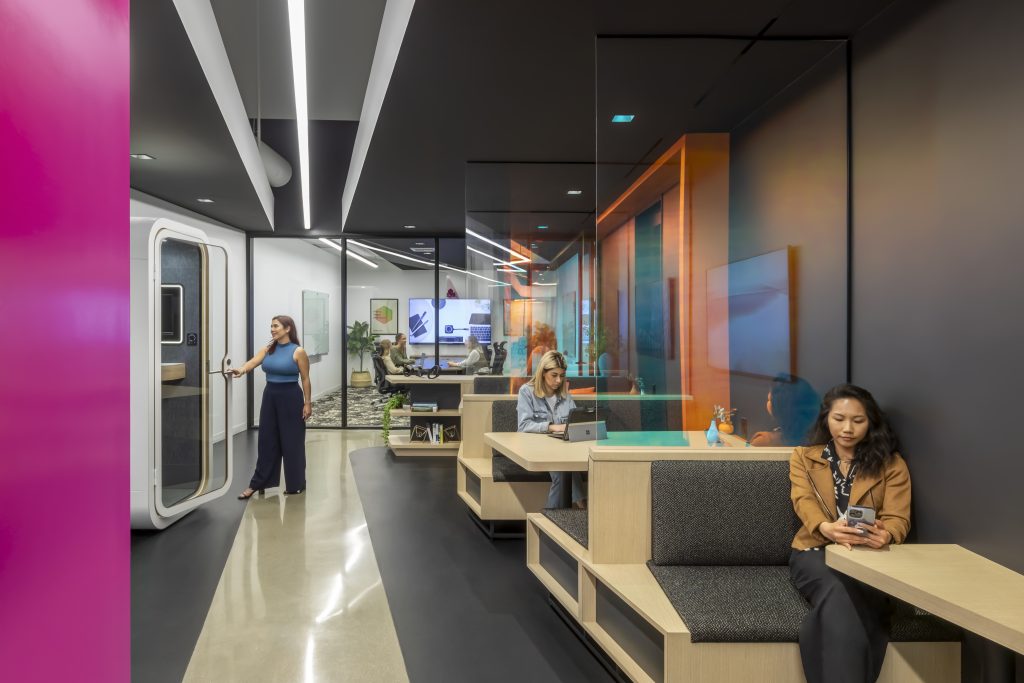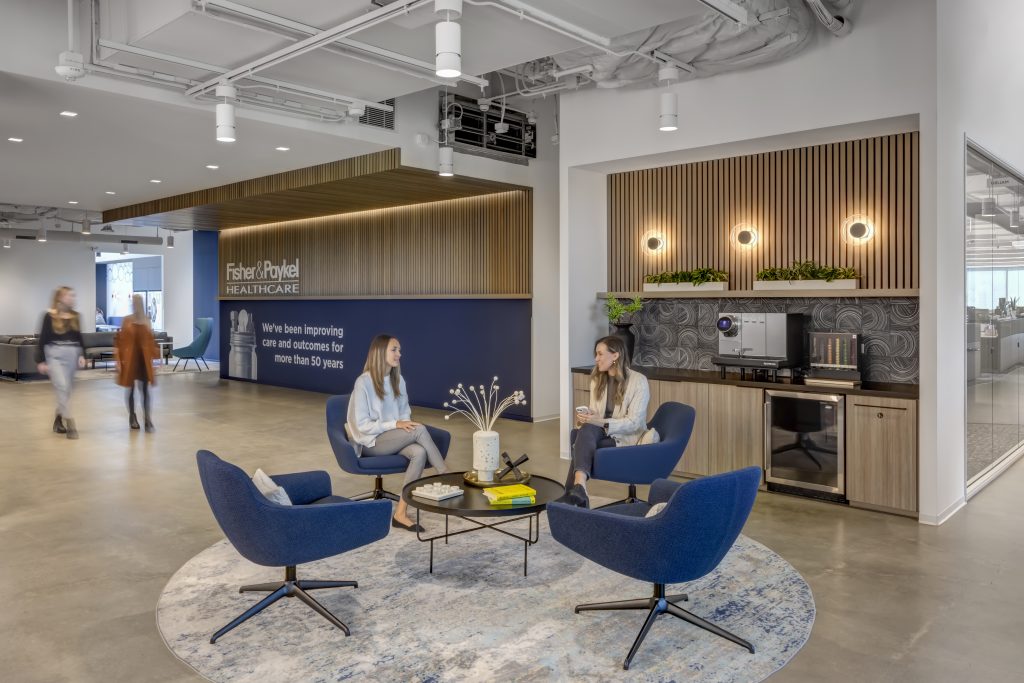- Traditional offices prioritized process, hierarchy, and task-oriented workflows, with spaces assigned based on title and status.
- Modern offices emphasize purpose, belonging, and community, promoting wellness, culture, and engagement to better accommodate employees’ evolving work needs.
- Creating a people-centric workplace boosts employee engagement, which leads to lower turnover, higher retention, and increased productivity and revenue for organizations.
This article was written by Anna Alm-Grayhek, Principal and Director of Workplace Strategy at Hendy, for Work Design Magazine.
There has been a lot of talk about creating offices that are more “People-Centric” or “Employee-Centric.” This recent phenomenon is a bit ironic because offices do not exist without people. And, by definition, an office is a place where people go to get work done and support the various goals of their organization.
With that in mind, we consider the question…
What Were Offices Focused on Before?
For the most part, it was process and hierarchy.
Workflows were task-oriented, much like an assembly line pushing paper, and spaces were assigned based on title and status within the organization. But for much of the workforce, the nature of work itself has dramatically changed.
The digital workplace, in which much of our work has been virtualized, means that tasks are independent of place and often of time. So why are offices still here? And why do they matter?
The Purpose-Driven Office
One reason is that workplaces offer a core element of what we need as human beings: a sense of purpose, belonging, and community. Over the past decade, much of our socialization has become virtualized – group chats and social media posts have replaced phone calls or gatherings that once happened in person.
But considering Maslow’s famous model, we all have an innate psychological need for a sense of community and are searching for our place to belong; a place where we can come together with others as a part of a shared goal.
Think about it, if work is how we spend a majority of our time outside our homes, then it seems logical that we should be investing in meaningful work locations and experiences.
The average person will spend 90,000 hours of their life working – that kind of time provides great opportunities to positively impact employees’ well-being, satisfaction, and happiness through a purposeful office.

Getting beyond Mandates & Coffee Badging
As the demand for talent has remained high, many organizations have surrendered to the employee expectation of hybrid work. Despite this, statistics show that some leadership teams have begun enforcing mandated in-office days to increase collaboration and culture building.
However, we are now hearing about the Coffee Badging phenomenon, whereby employees come to the office and badge swipe to prove that they came in. They grab a coffee, snack or complimentary lunch, only to leave and work elsewhere.
Why is this happening? The reasons may be varied – one simple answer that some leaders have concluded is that people are, in fact, not working. But a deeper dive will tell us that many employees are disconnected or feel distracted in the office and can’t get work done as effectively as they can at home.
Others may be dealing with personal circumstances that require alternative work schedules that aren’t apparent to management. Nevertheless, it is a fascinating tell that someone would undertake the commute, yet not see any value to actually “working” in the office.
When employees feel disengaged and aren’t connected to their organization, we run the risk of decreased performance and negative impacts to the company’s culture.
With 53% of remote workers saying it’s harder to feel connected to their coworkers in dispersed work settings, creating a physical workplace that provides an effective space to collaborate and socialize – while celebrating their unique culture – should be at the top of every executive’s list.
In short, it must be better than working from home.

Spaces Where People Can Thrive
So, what does it mean to be “People-Centric”? Philosophically it means that we put the employee first. We move beyond a mindset that’s focused only on efficiency to create places and experiences that are inspiring, comfortable, and purpose-built. They provide autonomy and choice to accommodate activity requirements throughout the day, varying needs throughout a project lifecycle, and individual preferences that will vary from person to person. They are places where employees’ needs are anticipated so that they can focus on coming together to connect, collaborate, and ultimately thrive.
And successful organizations want their employees to thrive – to see them grow and develop, both personally and professionally. The office is a vital component in creating the best talent, and there is no substitute for the serendipitous moments of learning and collaboration that happen when people are together in the same space.
Crafting a workplace that encourages these in-person interactions sets the team up for success.
But beware, building a better workplace is not a “build it and they will come” scenario. The people side of culture-building requires active participation from leaders, mentors, and human resources.
Change management efforts may be necessary to drive awareness about the benefits of meeting “in real life” – not just for the employees themselves, but for their peers.
Many younger colleagues are hungry for the knowledge possessed by those with seniority and experience. Physical proximity to these mentors can offer younger associates access to professional knowledge that can be challenging, if not impossible, to replicate in virtual environments. It is time to recognize and celebrate that fact, so that everyone takes ownership in the process of growing the organization.

The Way You Work Has Changed – Shouldn’t your Office?
Every organization has a unique culture, team dynamics, and ways of working. Understanding where the team is now – and where they want to be – is essential to creating a productive workplace that will engage that specific team. Three key ways that we’ve found to embrace the human side of the workplace include:
- Invest in Wellness: Provide elements that promote wellness (ergonomic furniture: varying heights/adjustability), natural materials, access to daylight/outside views, healthy snacks, wellness rooms, or relaxation spaces.
- Promote Culture & Collaboration: Discuss space types that promote collaboration and layouts for gathering and connecting. Incorporate migration patterns and touchpoints to create a memorable experience and encourage engagement. Consider integrating space for celebrations and events that are unique to your organization.
- Anticipate Employee Needs: Offer solutions for privacy, noise reduction, and focus spaces. Reduce any barriers to employees wanting to come into the office. And don’t forget to invest in technologies that create that seamless experience.
Increase Engagement (& the Bottom Line)
So, in the end, how does an Employee-Centric workplace benefit the organization? One very simple, yet important reason is that by meeting employee needs and improving their workplace experience, organizations can increase employee engagement.
This, in turn, results in lower rates of turnover, absenteeism, decreased recruitment and training costs, and increased retention of highly motived individuals – who will then pass along better service to their customers. In fact, a recent Gallup Survey shows a strong link between highly engaged organizations and a 23% increase in revenue.
Bottom line, without people, offices would simply be glorified storage facilities for outdated furniture, filing cabinets, and equipment. Let’s make them places where people want to be. Where they feel welcomed, comfortable, and ultimately productive.


 Dr. Gleb Tsipursky – The Office Whisperer
Dr. Gleb Tsipursky – The Office Whisperer Nirit Cohen – WorkFutures
Nirit Cohen – WorkFutures Angela Howard – Culture Expert
Angela Howard – Culture Expert Drew Jones – Design & Innovation
Drew Jones – Design & Innovation Jonathan Price – CRE & Flex Expert
Jonathan Price – CRE & Flex Expert















